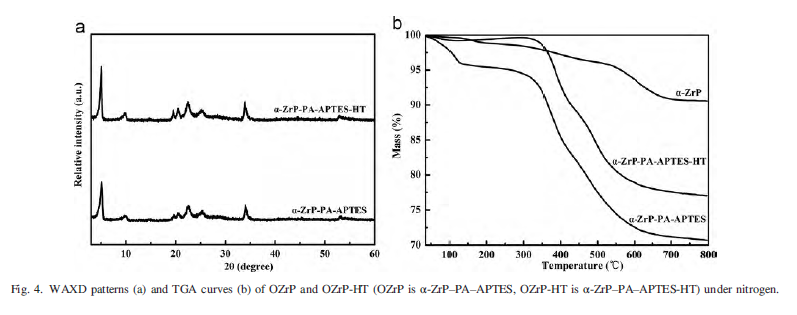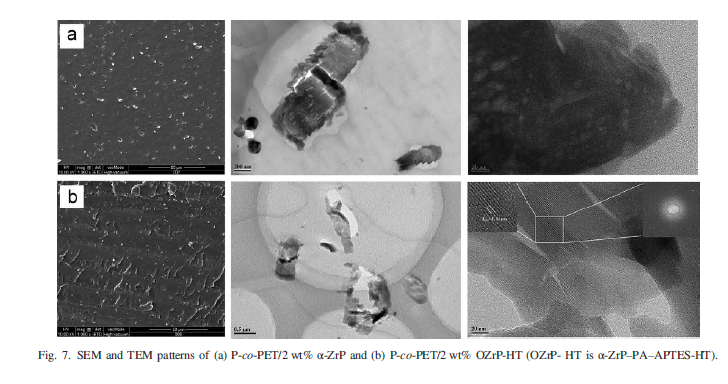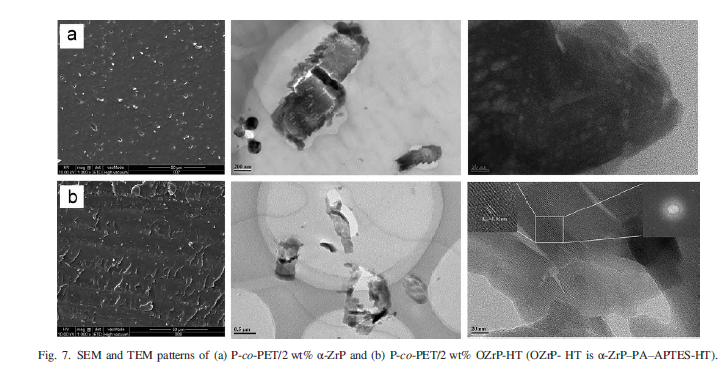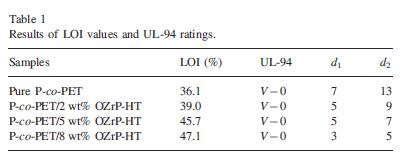Sunshine Factory, Co., Ltd. > Applications > ZrP for PolymerZrP for Polymer
Preparation and Performance of Lipophilic α-Zirconium Phosphate with High Thermal Stability and its Application in Ihermal-Plastic Polymers
Abstract
To prepare lipophilic α-zirconium phosphate with high grafting ratio and thermal stability (OZrP-HT) and explore its potential application in thermal-plastic polymers, a novel method was developed by surface lipophilicity enhancement strategy.
The commercial α-zirconium phosphate(α-ZrP) was pre-intercalated by n-propylamine (PA) and grafted by silane coupling agents. Then the pre-intercalated PA was removed by heattreatment, and the obtained OZrP-HT was utilized to fabricate the phosphorous-containing polyester (P-co-PET)/OZrP-HT nanocomposites by melt-blending method. The prepared OZrP-HT and P-co-PET/OZrP-HT nanocomposites were characterized by Wide Angle X-ray Diffraction(WAXD), Fourier Transform Infrared Spectroscopy (FTIR), Thermogravimetric Analysis (TGA), Transmission Electron Microscope (TEM), etc.
The results show that OZrP-HT with high grafting ratio (13.78 wt%) and thermal stability ( Tonset=368℃ ) was successfully prepared via this novel method and was uniformly intercalated by P-co-PET molecular chains. OZrP-HT had no significant effect on the fiber processability of P-co-PET polymer, and flame retardant properties of (P-co-PET)/OZrP-HT nanocomposites were improved. This method may be suitable for organic modification of general inorganic layered compounds and could extend the potential applications in thermo-plastic polymers.
Effect of heat-treatment on structure and performance of lipophilic α-ZrP






Conclusions
The structures and performances of novel OZrP-HT and P-co-PET/OZrP-HT nanocomposites were investigated in details. The OZrP-HT is of high grafting ratio about 13.78 wt% and high initial decomposition temperature about 368℃, its interlayer distance is about 1.74 nm and is beneficial for intercalation of polymer molecular chains. The OZrP-HT also shows well dispersibility in P-co-PET, its introduction has no significant effect on the thermo-stability and spinnablity of P-co-PET, and it can enhance the flame retardation and anti-drop performance of P-co-PET to some extent due to the synergistic effect.
To prepare lipophilic α-zirconium phosphate with high grafting ratio and thermal stability (OZrP-HT) and explore its potential application in thermal-plastic polymers, a novel method was developed by surface lipophilicity enhancement strategy.
The commercial α-zirconium phosphate(α-ZrP) was pre-intercalated by n-propylamine (PA) and grafted by silane coupling agents. Then the pre-intercalated PA was removed by heattreatment, and the obtained OZrP-HT was utilized to fabricate the phosphorous-containing polyester (P-co-PET)/OZrP-HT nanocomposites by melt-blending method. The prepared OZrP-HT and P-co-PET/OZrP-HT nanocomposites were characterized by Wide Angle X-ray Diffraction(WAXD), Fourier Transform Infrared Spectroscopy (FTIR), Thermogravimetric Analysis (TGA), Transmission Electron Microscope (TEM), etc.
The results show that OZrP-HT with high grafting ratio (13.78 wt%) and thermal stability ( Tonset=368℃ ) was successfully prepared via this novel method and was uniformly intercalated by P-co-PET molecular chains. OZrP-HT had no significant effect on the fiber processability of P-co-PET polymer, and flame retardant properties of (P-co-PET)/OZrP-HT nanocomposites were improved. This method may be suitable for organic modification of general inorganic layered compounds and could extend the potential applications in thermo-plastic polymers.
Effect of heat-treatment on structure and performance of lipophilic α-ZrP






Table 1, it can be found that pristine P-co-PET is highly nonflammable, its LOI value is 36.1% and is classified into the UL-94 V0 rating. Compared with it, the LOI values of composites increase markedly from 39.0% to 47.1% with the increase of OZrP-HT content from 2 wt% to 8 wt%, indicating that adding OZrP-HT can improve the flame retardation of P-co-PET. The UL-94 result shows that, the number of molten drops decreases with increasing the OZrP-HT content, and adding OZrP-HT can inhibit the molten drops from dripping as well as enhance the anti-drop performance of composites. The LOI and UL-94 results together indicate that OZrP-HT works as a synergist in P-co-PET, maybe it will also have synergistic effect with phosphorus-containing flame retardant on PET.
Conclusions
A novel method to prepare lipophilic α-zirconium phosphate with high grafting ratio and thermal stability (OZrP-HT) has been successfully developed. Commercial α-ZrP was preintercalated by n-propylamine (PA) firstly to increase the interlayer distance, then grafted by silane coupling agents to form covalent bonds, finally the lipophilic α-ZrP was heattreated to remove pre-intercalated PA and enhance the thermal stability of lipophilic α-ZrP. After that, the novel OZrP-HT was utilized to prepare the phosphorous-containing polyester (P-co-PET)/OZrP-HT nanocomposites by melt-blending method,as an application example in thermal-plastic polymers.
The structures and performances of novel OZrP-HT and P-co-PET/OZrP-HT nanocomposites were investigated in details. The OZrP-HT is of high grafting ratio about 13.78 wt% and high initial decomposition temperature about 368℃, its interlayer distance is about 1.74 nm and is beneficial for intercalation of polymer molecular chains. The OZrP-HT also shows well dispersibility in P-co-PET, its introduction has no significant effect on the thermo-stability and spinnablity of P-co-PET, and it can enhance the flame retardation and anti-drop performance of P-co-PET to some extent due to the synergistic effect.

Follow WeChat


